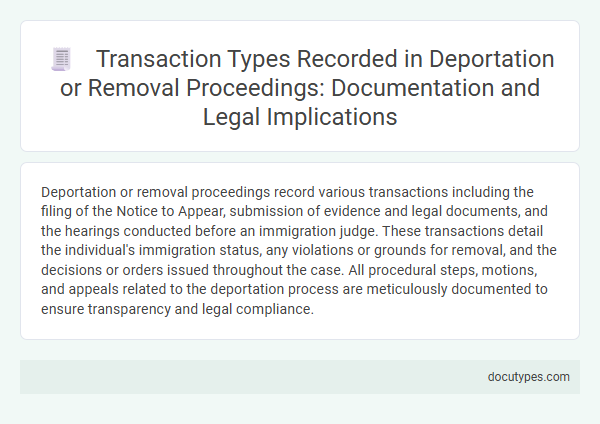Deportation or removal proceedings record various transactions including the filing of the Notice to Appear, submission of evidence and legal documents, and the hearings conducted before an immigration judge. These transactions detail the individual's immigration status, any violations or grounds for removal, and the decisions or orders issued throughout the case. All procedural steps, motions, and appeals related to the deportation process are meticulously documented to ensure transparency and legal compliance.
Overview of Transaction Types in Deportation Proceedings
Deportation or removal proceedings involve several key transaction types that record the progression of the case. These transactions document actions such as filing notices, court appearances, and decisions made by immigration authorities.
Common transaction types include the issuance of a Notice to Appear (NTA), bond hearings, and final removal orders. You can track these entries to understand the case's history and current status in the immigration system.
Key Documents Generated During Removal Processes
Deportation or removal proceedings generate critical documents that officially record the stages and decisions of the process. These documents serve as legal evidence and guide both the immigrant and government agencies throughout the case.
- Notice to Appear (NTA) - This document initiates removal proceedings by informing the individual of the allegations against them and the time and place of their hearing.
- Charging Document - Specifies the grounds for removal, detailing the legal basis for the deportation under immigration law.
- Immigration Judge's Decisions - Records rulings, orders, and final outcomes from the court hearings during removal proceedings.
Notice to Appear (NTA): Content and Handling
What types of transactions are recorded in deportation or removal proceedings? These proceedings primarily document the issuance and processing of a Notice to Appear (NTA), which initiates the case. The NTA outlines the alleged immigration violations and serves as the official notice to the individual for their hearing.
What is the content of a Notice to Appear (NTA) in removal proceedings? The NTA includes the respondent's personal information, the specific charges of removability, and the date and location of the immigration court hearing. Accurate documentation in the NTA is critical for ensuring procedural fairness and timely adjudication.
How is the Notice to Appear (NTA) handled in deportation cases? Immigration authorities serve the NTA to the individual either personally or by mail, and a copy is filed with the immigration court. The court then creates a record of the NTA in the electronic case management system to track the removal proceeding's status and actions.
Bonds, Custody, and Release Documentation
Deportation or removal proceedings document various transactions related to bonds, custody, and release. These records provide detailed information on the status and conditions of detainees throughout the legal process.
Bonds issued during proceedings specify the amount and terms under which an individual may be released from custody. Custody records track the detainee's location, duration, and any transfers between facilities. Release documentation includes conditions of release, such as electronic monitoring or check-in requirements, ensuring compliance with immigration authorities.
Orders of Removal: Creation and Implications
Orders of Removal are formal documents issued during deportation or removal proceedings. These orders record the government's decision to remove an individual from the United States based on violations of immigration laws.
The creation of an Order of Removal involves a thorough legal process, including hearings and evidence presentation. Your removal order has significant implications, affecting future immigration benefits and potential reentry into the country.
Voluntary Departure Agreements and Records
Deportation or removal proceedings involve various types of recorded transactions that detail an individual's immigration status and legal processes. Among these, voluntary departure agreements and their corresponding records play a critical role in the resolution of cases without formal removal orders.
- Voluntary Departure Agreement - A written agreement allowing an individual to leave the United States voluntarily within a specified time frame to avoid a formal removal order.
- Record of Voluntary Departure - Documentation confirming the individual's agreement to depart and the terms under which the voluntary departure was granted by immigration authorities.
- Compliance Verification - Records maintained to track whether the individual complied with the voluntary departure agreement, including deadlines and departure confirmation.
These records are essential for both legal compliance and future immigration benefits or limitations.
Motions Filed and Their Documentation Requirements
Motions filed in deportation or removal proceedings include requests for reopening, reconsideration, or administrative closure. Each motion requires specific documentation, such as evidence supporting new facts, legal arguments, or changes in circumstances. You must ensure all necessary documents are accurately submitted to avoid delays or denials in your case.
Appeals and Corresponding Legal Filings
Deportation or removal proceedings involve detailed records of legal transactions, particularly focusing on appeals and corresponding filings. These transactions document the procedural steps and legal arguments presented during the appeal of removal orders.
- Notice of Appeal - This filing initiates the appellate process by formally challenging the removal order with the Board of Immigration Appeals (BIA).
- Briefs and Motions - Legal briefs and motions submitted during appeals outline the grounds of the challenge, including requests for stays of removal or motions to reopen or reconsider the case.
- Decisions and Orders - Official records include the outcomes of appeals, such as BIA decisions or federal court rulings, which determine the final status of the removal proceeding.
Recordkeeping Standards for Deportation Cases
In deportation or removal proceedings, key transactions such as charging documents, hearing notices, evidence submissions, and final orders are meticulously recorded. Recordkeeping standards for deportation cases require maintaining detailed, accurate, and accessible files to ensure due process and proper case management. You must understand that compliance with these standards is essential for legal transparency and effective immigration enforcement.
What Types of Transactions Are Recorded in Deportation or Removal Proceedings? Infographic

